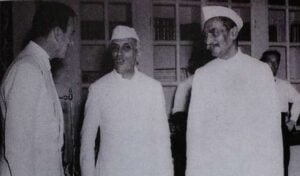
Lord Mountbatten with Pt. Jawaharlal Nehru and Dr. Rajendra Prasad | Credit: Wikimedia Commons
The Indian Independence Act, 1947 was an act that granted independence to India and Pakistan and ended British rule in India. It was based on the Mountbatten Plan, which was accepted by the Indian National Congress, the Muslim League and other parties. It provided for the following:
- It declared India and Pakistan as two independent dominions from August 15, 1947. The British Crown ceased to be the source of authority for these dominions, and they were free to frame their own constitutions and choose their own heads of state.
- It partitioned India into two parts: India and Pakistan (including present-day Pakistan, Bangladesh and some parts of Afghanistan). The partition of India also created East and West Pakistan, which were the eastern and western wings of the Dominion of Pakistan. East Pakistan later became Bangladesh in 1971 after a war of independence. West Pakistan is now the Islamic Republic of Pakistan. The boundary between them was determined by a Boundary Commission headed by Sir Cyril Radcliffe.
- The Act did not decide the fate of the princely states, which were the small kingdoms ruled by local kings or princes. They could join India or Pakistan or stay separate. The Act also suggested that they should join the country that was geographically closer to them and had more people of their religion or community. To join a country, they had to sign a legal document called the Instrument of Accession. The Instrument of Accession allowed the rulers of the princely states to join either India or Pakistan after 1947. It gave them some rights and duties. For example, they had to accept the constitution and laws of that country but had the right to their property. Changes to these rights were gradually made.
- It abolished the office of the Viceroy and the Governor-General in India and Pakistan. The Governor-General was the chief administrator of British India and held wide-ranging powers to govern the country. The Governor-General was appointed by the British Crown and was responsible for the administration of British India through The Charter Act of 1833.
- The Indian Independence Act, 1947 abolished this office in both India and Pakistan, and replaced it with a Governor-General for each dominion. The Governor-General was appointed by the King of England. The Governor-General was supposed to act as a ceremonial head who followed the advice of the cabinet ministers of that dominion. He did not have any real power or influence over the affairs of that country. Chakravarti Rajagopalachari was the last Governor General of Independent India.
- It transferred all powers and obligations of the British government relating to India and Pakistan to their respective governments. It also terminated all treaties and agreements between Britain and India or Pakistan or any Indian state.
- It provided for a common Governor-General for both dominions until March 31, 1948, or until one of them made other arrangements.
Continue to the next section: Parts of the Indian Constitution
